Comprehensive Review of the Beck Depression Inventory-II
VerifiedAdded on 2020/10/04
|7
|2240
|79
AI Summary
The assignment provides a detailed analysis of the Beck Depression Inventory-II (BDI-II), a widely used self-report questionnaire for assessing symptoms of depression. It reviews various studies that have examined the psychometric properties of the BDI-II, including its factor structure, reliability, and validity. The assignment also compares the BDI-II with other depression measures, such as the Patient Health Questionnaire (PHQ-9) and the Hospital Anxiety and Depression Scale (HADS). Additionally, it discusses the use of the BDI-II in different populations, including healthy individuals and patients with mental health conditions.
Contribute Materials
Your contribution can guide someone’s learning journey. Share your
documents today.
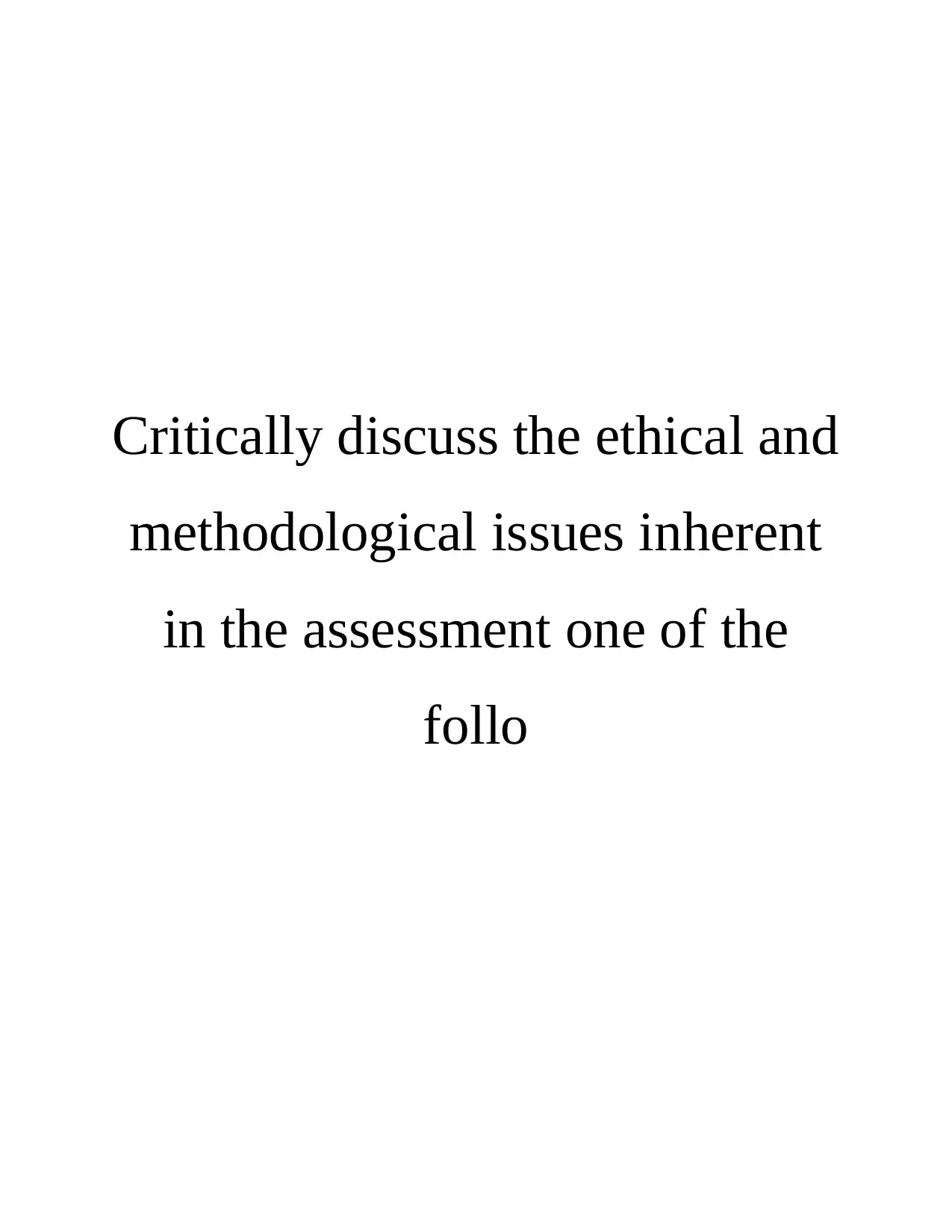
Critically discuss the ethical and
methodological issues inherent
in the assessment one of the
follo
methodological issues inherent
in the assessment one of the
follo
Secure Best Marks with AI Grader
Need help grading? Try our AI Grader for instant feedback on your assignments.
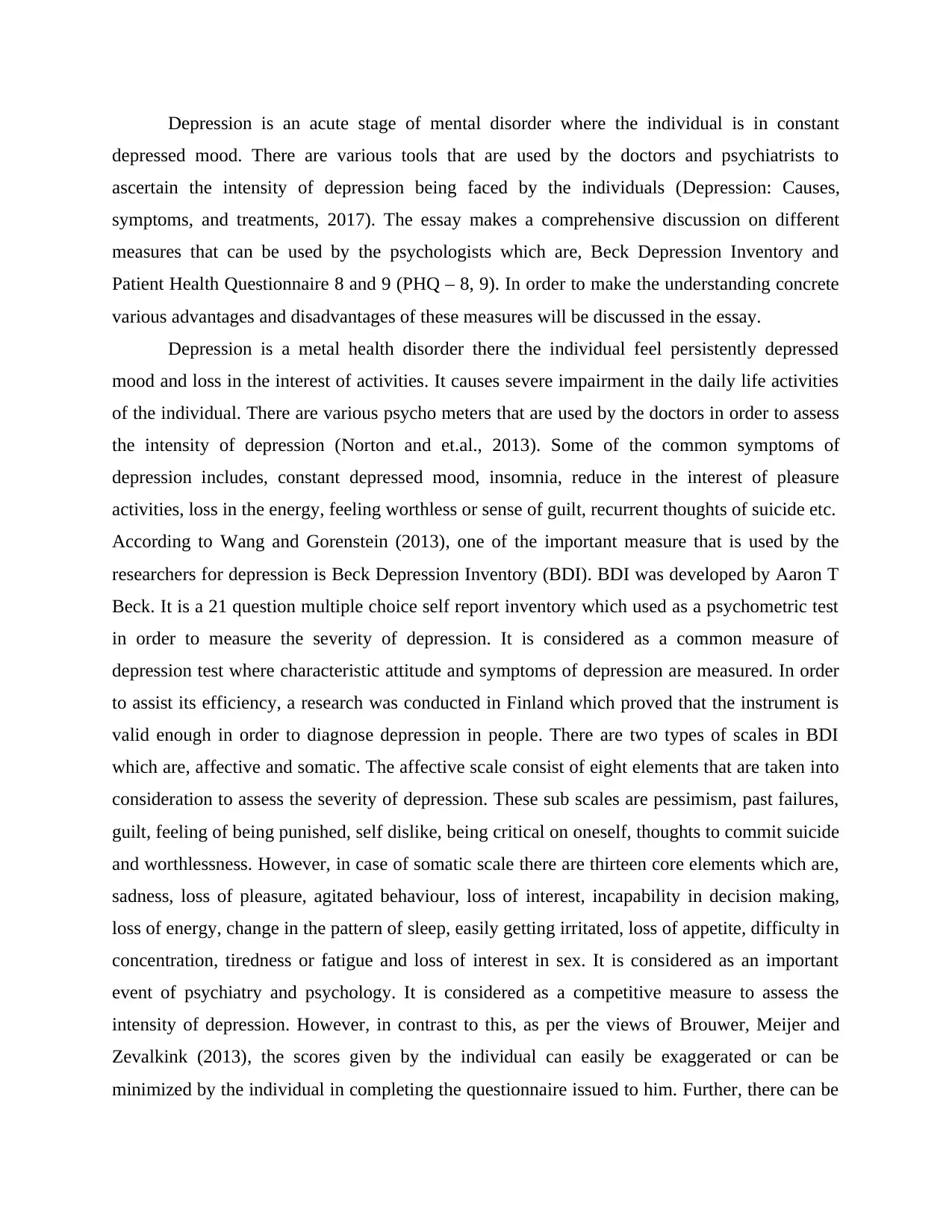
Depression is an acute stage of mental disorder where the individual is in constant
depressed mood. There are various tools that are used by the doctors and psychiatrists to
ascertain the intensity of depression being faced by the individuals (Depression: Causes,
symptoms, and treatments, 2017). The essay makes a comprehensive discussion on different
measures that can be used by the psychologists which are, Beck Depression Inventory and
Patient Health Questionnaire 8 and 9 (PHQ – 8, 9). In order to make the understanding concrete
various advantages and disadvantages of these measures will be discussed in the essay.
Depression is a metal health disorder there the individual feel persistently depressed
mood and loss in the interest of activities. It causes severe impairment in the daily life activities
of the individual. There are various psycho meters that are used by the doctors in order to assess
the intensity of depression (Norton and et.al., 2013). Some of the common symptoms of
depression includes, constant depressed mood, insomnia, reduce in the interest of pleasure
activities, loss in the energy, feeling worthless or sense of guilt, recurrent thoughts of suicide etc.
According to Wang and Gorenstein (2013), one of the important measure that is used by the
researchers for depression is Beck Depression Inventory (BDI). BDI was developed by Aaron T
Beck. It is a 21 question multiple choice self report inventory which used as a psychometric test
in order to measure the severity of depression. It is considered as a common measure of
depression test where characteristic attitude and symptoms of depression are measured. In order
to assist its efficiency, a research was conducted in Finland which proved that the instrument is
valid enough in order to diagnose depression in people. There are two types of scales in BDI
which are, affective and somatic. The affective scale consist of eight elements that are taken into
consideration to assess the severity of depression. These sub scales are pessimism, past failures,
guilt, feeling of being punished, self dislike, being critical on oneself, thoughts to commit suicide
and worthlessness. However, in case of somatic scale there are thirteen core elements which are,
sadness, loss of pleasure, agitated behaviour, loss of interest, incapability in decision making,
loss of energy, change in the pattern of sleep, easily getting irritated, loss of appetite, difficulty in
concentration, tiredness or fatigue and loss of interest in sex. It is considered as an important
event of psychiatry and psychology. It is considered as a competitive measure to assess the
intensity of depression. However, in contrast to this, as per the views of Brouwer, Meijer and
Zevalkink (2013), the scores given by the individual can easily be exaggerated or can be
minimized by the individual in completing the questionnaire issued to him. Further, there can be
depressed mood. There are various tools that are used by the doctors and psychiatrists to
ascertain the intensity of depression being faced by the individuals (Depression: Causes,
symptoms, and treatments, 2017). The essay makes a comprehensive discussion on different
measures that can be used by the psychologists which are, Beck Depression Inventory and
Patient Health Questionnaire 8 and 9 (PHQ – 8, 9). In order to make the understanding concrete
various advantages and disadvantages of these measures will be discussed in the essay.
Depression is a metal health disorder there the individual feel persistently depressed
mood and loss in the interest of activities. It causes severe impairment in the daily life activities
of the individual. There are various psycho meters that are used by the doctors in order to assess
the intensity of depression (Norton and et.al., 2013). Some of the common symptoms of
depression includes, constant depressed mood, insomnia, reduce in the interest of pleasure
activities, loss in the energy, feeling worthless or sense of guilt, recurrent thoughts of suicide etc.
According to Wang and Gorenstein (2013), one of the important measure that is used by the
researchers for depression is Beck Depression Inventory (BDI). BDI was developed by Aaron T
Beck. It is a 21 question multiple choice self report inventory which used as a psychometric test
in order to measure the severity of depression. It is considered as a common measure of
depression test where characteristic attitude and symptoms of depression are measured. In order
to assist its efficiency, a research was conducted in Finland which proved that the instrument is
valid enough in order to diagnose depression in people. There are two types of scales in BDI
which are, affective and somatic. The affective scale consist of eight elements that are taken into
consideration to assess the severity of depression. These sub scales are pessimism, past failures,
guilt, feeling of being punished, self dislike, being critical on oneself, thoughts to commit suicide
and worthlessness. However, in case of somatic scale there are thirteen core elements which are,
sadness, loss of pleasure, agitated behaviour, loss of interest, incapability in decision making,
loss of energy, change in the pattern of sleep, easily getting irritated, loss of appetite, difficulty in
concentration, tiredness or fatigue and loss of interest in sex. It is considered as an important
event of psychiatry and psychology. It is considered as a competitive measure to assess the
intensity of depression. However, in contrast to this, as per the views of Brouwer, Meijer and
Zevalkink (2013), the scores given by the individual can easily be exaggerated or can be
minimized by the individual in completing the questionnaire issued to him. Further, there can be
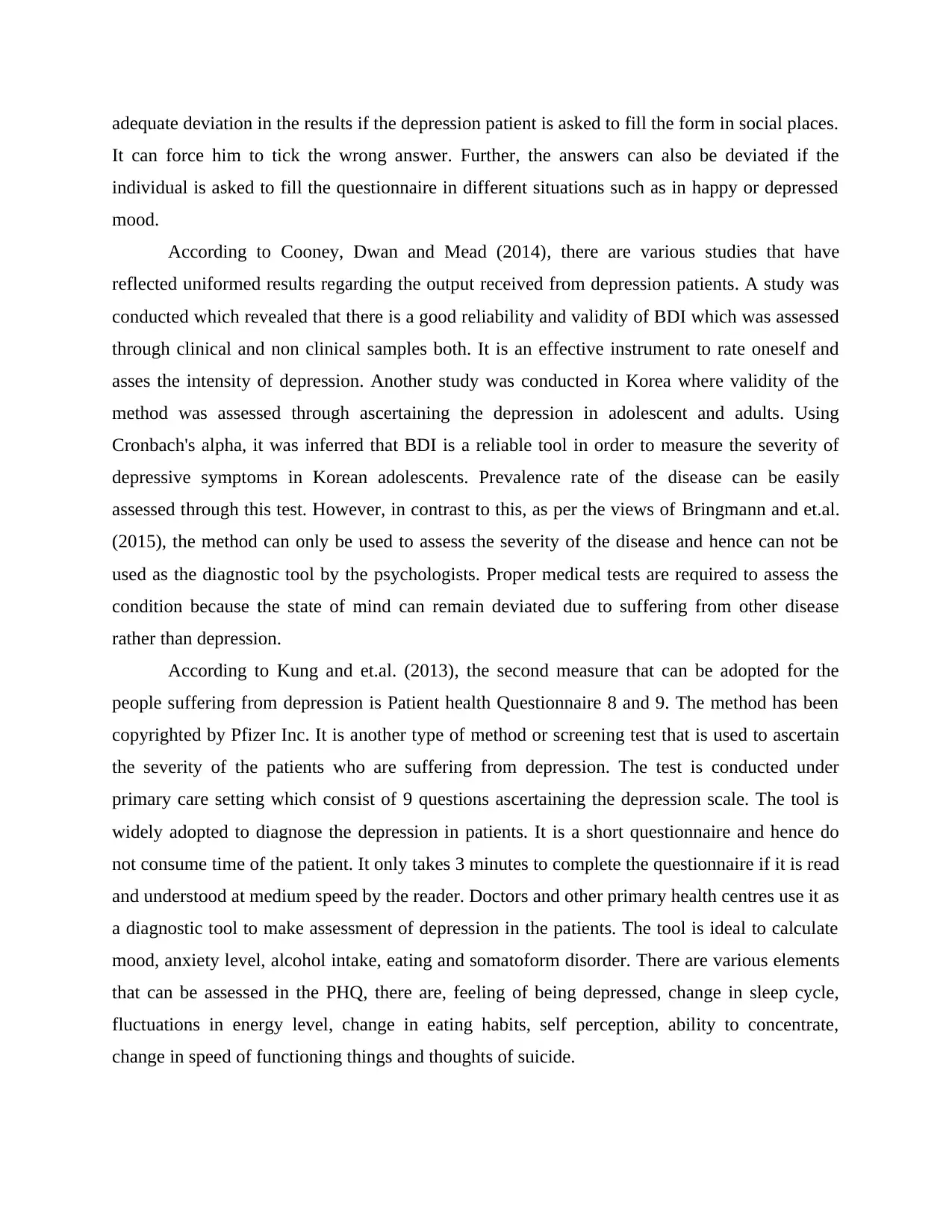
adequate deviation in the results if the depression patient is asked to fill the form in social places.
It can force him to tick the wrong answer. Further, the answers can also be deviated if the
individual is asked to fill the questionnaire in different situations such as in happy or depressed
mood.
According to Cooney, Dwan and Mead (2014), there are various studies that have
reflected uniformed results regarding the output received from depression patients. A study was
conducted which revealed that there is a good reliability and validity of BDI which was assessed
through clinical and non clinical samples both. It is an effective instrument to rate oneself and
asses the intensity of depression. Another study was conducted in Korea where validity of the
method was assessed through ascertaining the depression in adolescent and adults. Using
Cronbach's alpha, it was inferred that BDI is a reliable tool in order to measure the severity of
depressive symptoms in Korean adolescents. Prevalence rate of the disease can be easily
assessed through this test. However, in contrast to this, as per the views of Bringmann and et.al.
(2015), the method can only be used to assess the severity of the disease and hence can not be
used as the diagnostic tool by the psychologists. Proper medical tests are required to assess the
condition because the state of mind can remain deviated due to suffering from other disease
rather than depression.
According to Kung and et.al. (2013), the second measure that can be adopted for the
people suffering from depression is Patient health Questionnaire 8 and 9. The method has been
copyrighted by Pfizer Inc. It is another type of method or screening test that is used to ascertain
the severity of the patients who are suffering from depression. The test is conducted under
primary care setting which consist of 9 questions ascertaining the depression scale. The tool is
widely adopted to diagnose the depression in patients. It is a short questionnaire and hence do
not consume time of the patient. It only takes 3 minutes to complete the questionnaire if it is read
and understood at medium speed by the reader. Doctors and other primary health centres use it as
a diagnostic tool to make assessment of depression in the patients. The tool is ideal to calculate
mood, anxiety level, alcohol intake, eating and somatoform disorder. There are various elements
that can be assessed in the PHQ, there are, feeling of being depressed, change in sleep cycle,
fluctuations in energy level, change in eating habits, self perception, ability to concentrate,
change in speed of functioning things and thoughts of suicide.
It can force him to tick the wrong answer. Further, the answers can also be deviated if the
individual is asked to fill the questionnaire in different situations such as in happy or depressed
mood.
According to Cooney, Dwan and Mead (2014), there are various studies that have
reflected uniformed results regarding the output received from depression patients. A study was
conducted which revealed that there is a good reliability and validity of BDI which was assessed
through clinical and non clinical samples both. It is an effective instrument to rate oneself and
asses the intensity of depression. Another study was conducted in Korea where validity of the
method was assessed through ascertaining the depression in adolescent and adults. Using
Cronbach's alpha, it was inferred that BDI is a reliable tool in order to measure the severity of
depressive symptoms in Korean adolescents. Prevalence rate of the disease can be easily
assessed through this test. However, in contrast to this, as per the views of Bringmann and et.al.
(2015), the method can only be used to assess the severity of the disease and hence can not be
used as the diagnostic tool by the psychologists. Proper medical tests are required to assess the
condition because the state of mind can remain deviated due to suffering from other disease
rather than depression.
According to Kung and et.al. (2013), the second measure that can be adopted for the
people suffering from depression is Patient health Questionnaire 8 and 9. The method has been
copyrighted by Pfizer Inc. It is another type of method or screening test that is used to ascertain
the severity of the patients who are suffering from depression. The test is conducted under
primary care setting which consist of 9 questions ascertaining the depression scale. The tool is
widely adopted to diagnose the depression in patients. It is a short questionnaire and hence do
not consume time of the patient. It only takes 3 minutes to complete the questionnaire if it is read
and understood at medium speed by the reader. Doctors and other primary health centres use it as
a diagnostic tool to make assessment of depression in the patients. The tool is ideal to calculate
mood, anxiety level, alcohol intake, eating and somatoform disorder. There are various elements
that can be assessed in the PHQ, there are, feeling of being depressed, change in sleep cycle,
fluctuations in energy level, change in eating habits, self perception, ability to concentrate,
change in speed of functioning things and thoughts of suicide.
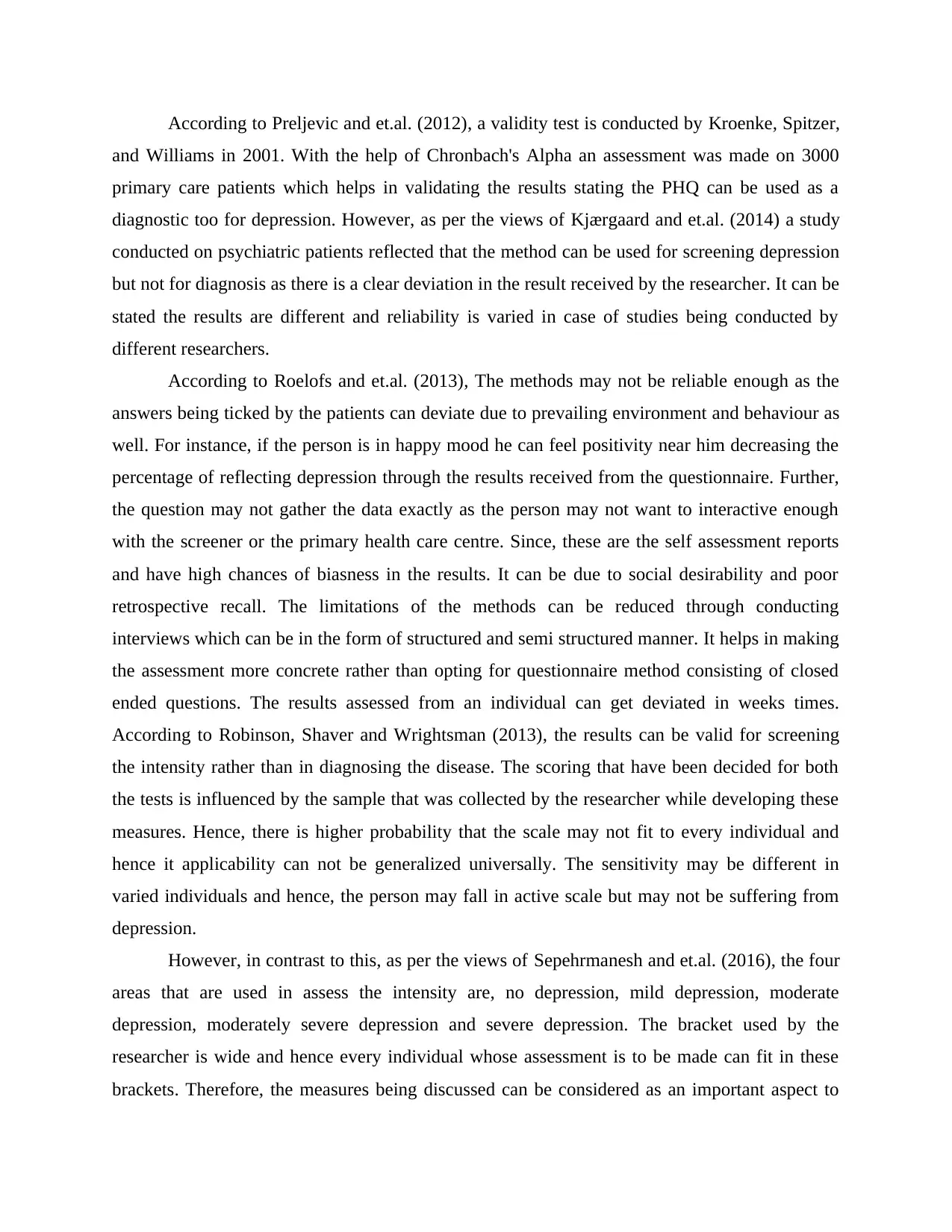
According to Preljevic and et.al. (2012), a validity test is conducted by Kroenke, Spitzer,
and Williams in 2001. With the help of Chronbach's Alpha an assessment was made on 3000
primary care patients which helps in validating the results stating the PHQ can be used as a
diagnostic too for depression. However, as per the views of Kjærgaard and et.al. (2014) a study
conducted on psychiatric patients reflected that the method can be used for screening depression
but not for diagnosis as there is a clear deviation in the result received by the researcher. It can be
stated the results are different and reliability is varied in case of studies being conducted by
different researchers.
According to Roelofs and et.al. (2013), The methods may not be reliable enough as the
answers being ticked by the patients can deviate due to prevailing environment and behaviour as
well. For instance, if the person is in happy mood he can feel positivity near him decreasing the
percentage of reflecting depression through the results received from the questionnaire. Further,
the question may not gather the data exactly as the person may not want to interactive enough
with the screener or the primary health care centre. Since, these are the self assessment reports
and have high chances of biasness in the results. It can be due to social desirability and poor
retrospective recall. The limitations of the methods can be reduced through conducting
interviews which can be in the form of structured and semi structured manner. It helps in making
the assessment more concrete rather than opting for questionnaire method consisting of closed
ended questions. The results assessed from an individual can get deviated in weeks times.
According to Robinson, Shaver and Wrightsman (2013), the results can be valid for screening
the intensity rather than in diagnosing the disease. The scoring that have been decided for both
the tests is influenced by the sample that was collected by the researcher while developing these
measures. Hence, there is higher probability that the scale may not fit to every individual and
hence it applicability can not be generalized universally. The sensitivity may be different in
varied individuals and hence, the person may fall in active scale but may not be suffering from
depression.
However, in contrast to this, as per the views of Sepehrmanesh and et.al. (2016), the four
areas that are used in assess the intensity are, no depression, mild depression, moderate
depression, moderately severe depression and severe depression. The bracket used by the
researcher is wide and hence every individual whose assessment is to be made can fit in these
brackets. Therefore, the measures being discussed can be considered as an important aspect to
and Williams in 2001. With the help of Chronbach's Alpha an assessment was made on 3000
primary care patients which helps in validating the results stating the PHQ can be used as a
diagnostic too for depression. However, as per the views of Kjærgaard and et.al. (2014) a study
conducted on psychiatric patients reflected that the method can be used for screening depression
but not for diagnosis as there is a clear deviation in the result received by the researcher. It can be
stated the results are different and reliability is varied in case of studies being conducted by
different researchers.
According to Roelofs and et.al. (2013), The methods may not be reliable enough as the
answers being ticked by the patients can deviate due to prevailing environment and behaviour as
well. For instance, if the person is in happy mood he can feel positivity near him decreasing the
percentage of reflecting depression through the results received from the questionnaire. Further,
the question may not gather the data exactly as the person may not want to interactive enough
with the screener or the primary health care centre. Since, these are the self assessment reports
and have high chances of biasness in the results. It can be due to social desirability and poor
retrospective recall. The limitations of the methods can be reduced through conducting
interviews which can be in the form of structured and semi structured manner. It helps in making
the assessment more concrete rather than opting for questionnaire method consisting of closed
ended questions. The results assessed from an individual can get deviated in weeks times.
According to Robinson, Shaver and Wrightsman (2013), the results can be valid for screening
the intensity rather than in diagnosing the disease. The scoring that have been decided for both
the tests is influenced by the sample that was collected by the researcher while developing these
measures. Hence, there is higher probability that the scale may not fit to every individual and
hence it applicability can not be generalized universally. The sensitivity may be different in
varied individuals and hence, the person may fall in active scale but may not be suffering from
depression.
However, in contrast to this, as per the views of Sepehrmanesh and et.al. (2016), the four
areas that are used in assess the intensity are, no depression, mild depression, moderate
depression, moderately severe depression and severe depression. The bracket used by the
researcher is wide and hence every individual whose assessment is to be made can fit in these
brackets. Therefore, the measures being discussed can be considered as an important aspect to
Secure Best Marks with AI Grader
Need help grading? Try our AI Grader for instant feedback on your assignments.
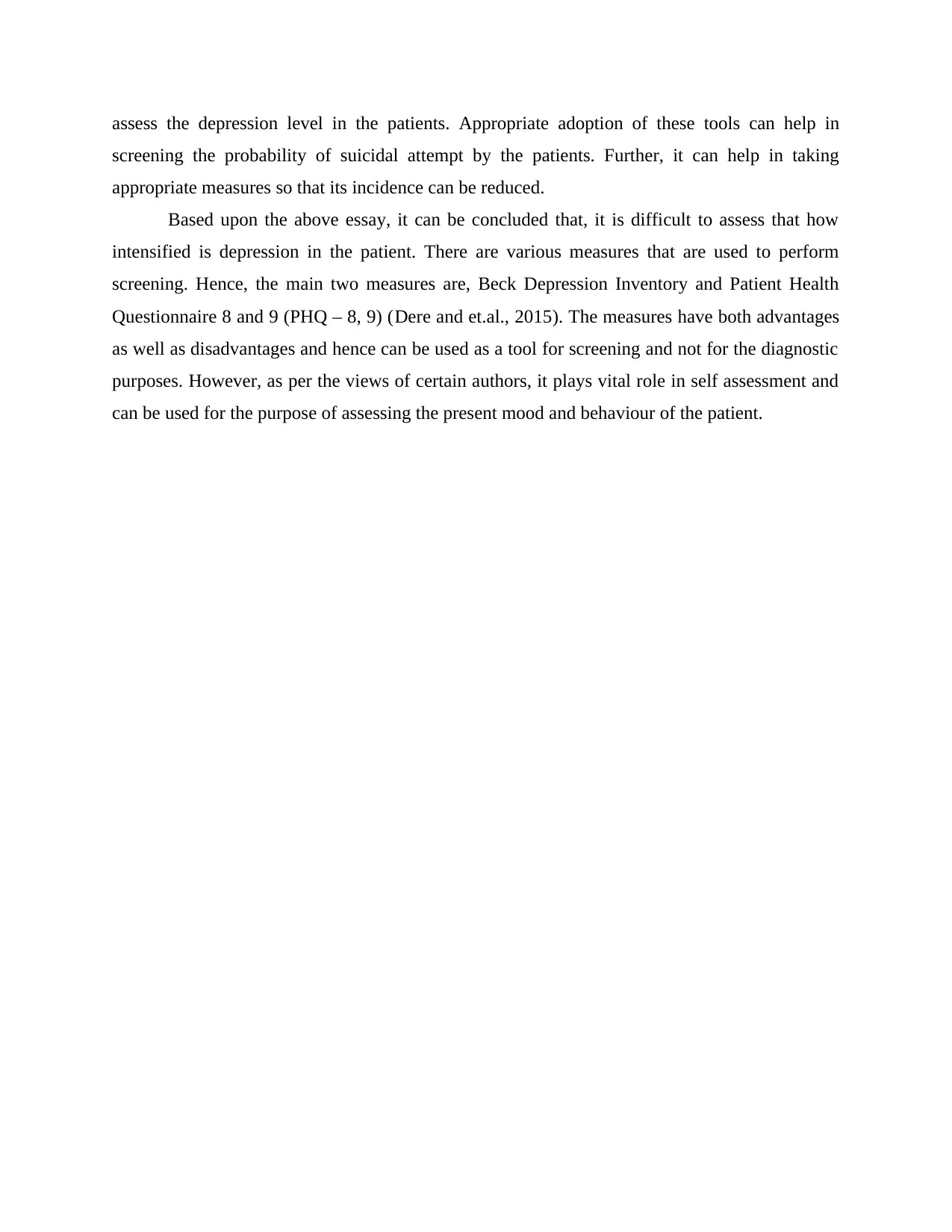
assess the depression level in the patients. Appropriate adoption of these tools can help in
screening the probability of suicidal attempt by the patients. Further, it can help in taking
appropriate measures so that its incidence can be reduced.
Based upon the above essay, it can be concluded that, it is difficult to assess that how
intensified is depression in the patient. There are various measures that are used to perform
screening. Hence, the main two measures are, Beck Depression Inventory and Patient Health
Questionnaire 8 and 9 (PHQ – 8, 9) (Dere and et.al., 2015). The measures have both advantages
as well as disadvantages and hence can be used as a tool for screening and not for the diagnostic
purposes. However, as per the views of certain authors, it plays vital role in self assessment and
can be used for the purpose of assessing the present mood and behaviour of the patient.
screening the probability of suicidal attempt by the patients. Further, it can help in taking
appropriate measures so that its incidence can be reduced.
Based upon the above essay, it can be concluded that, it is difficult to assess that how
intensified is depression in the patient. There are various measures that are used to perform
screening. Hence, the main two measures are, Beck Depression Inventory and Patient Health
Questionnaire 8 and 9 (PHQ – 8, 9) (Dere and et.al., 2015). The measures have both advantages
as well as disadvantages and hence can be used as a tool for screening and not for the diagnostic
purposes. However, as per the views of certain authors, it plays vital role in self assessment and
can be used for the purpose of assessing the present mood and behaviour of the patient.
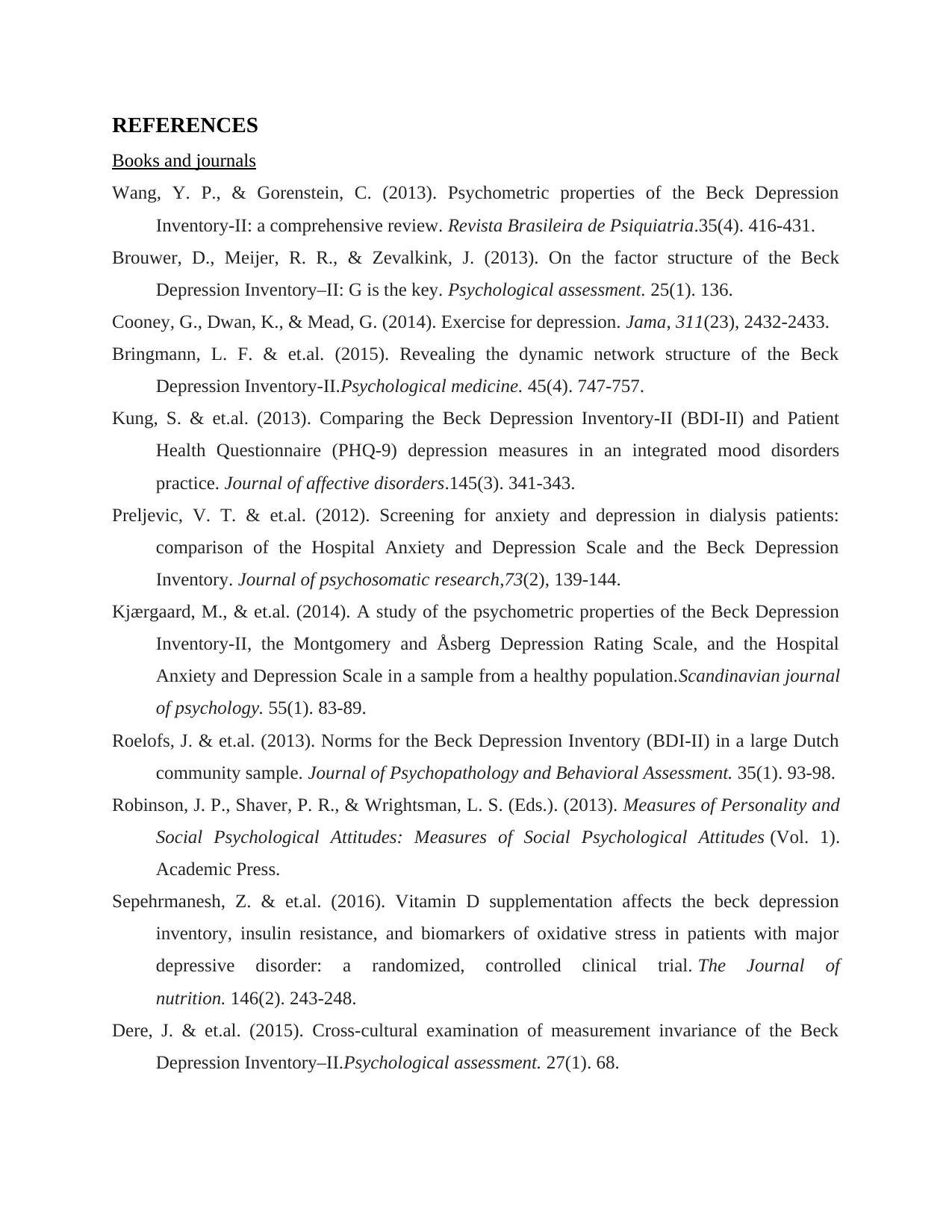
REFERENCES
Books and journals
Wang, Y. P., & Gorenstein, C. (2013). Psychometric properties of the Beck Depression
Inventory-II: a comprehensive review. Revista Brasileira de Psiquiatria.35(4). 416-431.
Brouwer, D., Meijer, R. R., & Zevalkink, J. (2013). On the factor structure of the Beck
Depression Inventory–II: G is the key. Psychological assessment. 25(1). 136.
Cooney, G., Dwan, K., & Mead, G. (2014). Exercise for depression. Jama, 311(23), 2432-2433.
Bringmann, L. F. & et.al. (2015). Revealing the dynamic network structure of the Beck
Depression Inventory-II.Psychological medicine. 45(4). 747-757.
Kung, S. & et.al. (2013). Comparing the Beck Depression Inventory-II (BDI-II) and Patient
Health Questionnaire (PHQ-9) depression measures in an integrated mood disorders
practice. Journal of affective disorders.145(3). 341-343.
Preljevic, V. T. & et.al. (2012). Screening for anxiety and depression in dialysis patients:
comparison of the Hospital Anxiety and Depression Scale and the Beck Depression
Inventory. Journal of psychosomatic research,73(2), 139-144.
Kjærgaard, M., & et.al. (2014). A study of the psychometric properties of the Beck Depression
Inventory‐II, the Montgomery and Åsberg Depression Rating Scale, and the Hospital
Anxiety and Depression Scale in a sample from a healthy population.Scandinavian journal
of psychology. 55(1). 83-89.
Roelofs, J. & et.al. (2013). Norms for the Beck Depression Inventory (BDI-II) in a large Dutch
community sample. Journal of Psychopathology and Behavioral Assessment. 35(1). 93-98.
Robinson, J. P., Shaver, P. R., & Wrightsman, L. S. (Eds.). (2013). Measures of Personality and
Social Psychological Attitudes: Measures of Social Psychological Attitudes (Vol. 1).
Academic Press.
Sepehrmanesh, Z. & et.al. (2016). Vitamin D supplementation affects the beck depression
inventory, insulin resistance, and biomarkers of oxidative stress in patients with major
depressive disorder: a randomized, controlled clinical trial. The Journal of
nutrition. 146(2). 243-248.
Dere, J. & et.al. (2015). Cross-cultural examination of measurement invariance of the Beck
Depression Inventory–II.Psychological assessment. 27(1). 68.
Books and journals
Wang, Y. P., & Gorenstein, C. (2013). Psychometric properties of the Beck Depression
Inventory-II: a comprehensive review. Revista Brasileira de Psiquiatria.35(4). 416-431.
Brouwer, D., Meijer, R. R., & Zevalkink, J. (2013). On the factor structure of the Beck
Depression Inventory–II: G is the key. Psychological assessment. 25(1). 136.
Cooney, G., Dwan, K., & Mead, G. (2014). Exercise for depression. Jama, 311(23), 2432-2433.
Bringmann, L. F. & et.al. (2015). Revealing the dynamic network structure of the Beck
Depression Inventory-II.Psychological medicine. 45(4). 747-757.
Kung, S. & et.al. (2013). Comparing the Beck Depression Inventory-II (BDI-II) and Patient
Health Questionnaire (PHQ-9) depression measures in an integrated mood disorders
practice. Journal of affective disorders.145(3). 341-343.
Preljevic, V. T. & et.al. (2012). Screening for anxiety and depression in dialysis patients:
comparison of the Hospital Anxiety and Depression Scale and the Beck Depression
Inventory. Journal of psychosomatic research,73(2), 139-144.
Kjærgaard, M., & et.al. (2014). A study of the psychometric properties of the Beck Depression
Inventory‐II, the Montgomery and Åsberg Depression Rating Scale, and the Hospital
Anxiety and Depression Scale in a sample from a healthy population.Scandinavian journal
of psychology. 55(1). 83-89.
Roelofs, J. & et.al. (2013). Norms for the Beck Depression Inventory (BDI-II) in a large Dutch
community sample. Journal of Psychopathology and Behavioral Assessment. 35(1). 93-98.
Robinson, J. P., Shaver, P. R., & Wrightsman, L. S. (Eds.). (2013). Measures of Personality and
Social Psychological Attitudes: Measures of Social Psychological Attitudes (Vol. 1).
Academic Press.
Sepehrmanesh, Z. & et.al. (2016). Vitamin D supplementation affects the beck depression
inventory, insulin resistance, and biomarkers of oxidative stress in patients with major
depressive disorder: a randomized, controlled clinical trial. The Journal of
nutrition. 146(2). 243-248.
Dere, J. & et.al. (2015). Cross-cultural examination of measurement invariance of the Beck
Depression Inventory–II.Psychological assessment. 27(1). 68.
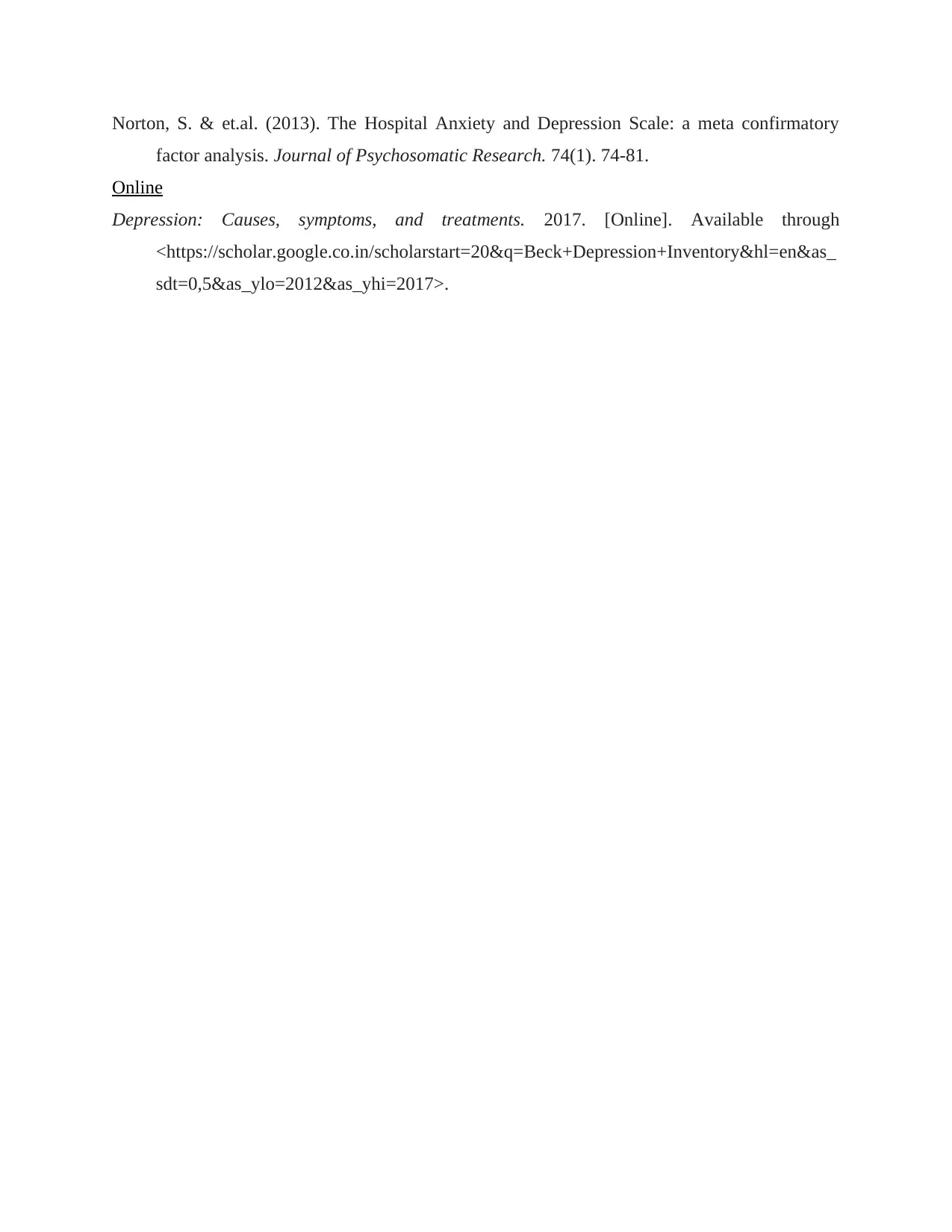
Norton, S. & et.al. (2013). The Hospital Anxiety and Depression Scale: a meta confirmatory
factor analysis. Journal of Psychosomatic Research. 74(1). 74-81.
Online
Depression: Causes, symptoms, and treatments. 2017. [Online]. Available through
<https://scholar.google.co.in/scholarstart=20&q=Beck+Depression+Inventory&hl=en&as_
sdt=0,5&as_ylo=2012&as_yhi=2017>.
factor analysis. Journal of Psychosomatic Research. 74(1). 74-81.
Online
Depression: Causes, symptoms, and treatments. 2017. [Online]. Available through
<https://scholar.google.co.in/scholarstart=20&q=Beck+Depression+Inventory&hl=en&as_
sdt=0,5&as_ylo=2012&as_yhi=2017>.
1 out of 7
Related Documents
Your All-in-One AI-Powered Toolkit for Academic Success.
+13062052269
info@desklib.com
Available 24*7 on WhatsApp / Email
![[object Object]](/_next/static/media/star-bottom.7253800d.svg)
Unlock your academic potential
© 2024 | Zucol Services PVT LTD | All rights reserved.





